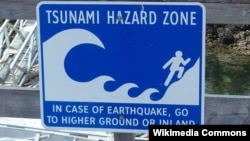There are coastal towns all around the world where tsunamis could and have caused loss of life and massive destruction. For people living in such areas the ability to reach higher ground as soon as possible is important.
Tsunamis are unexpected huge ocean waves. Earthquakes are often the cause of tsunamis. And that can interfere with escape.
What if the wreckage from an earthquake blocks the path to high ground? One coastal town in Washington State is copying a method used in Japan to survive tsunamis. Westport, Washington, is building the first U.S. vertical tsunami shelter.
Next year, Ocosta Elementary School will have a new gym with an especially strong roof that can serve as a tsunami refuge. This will be the first structure in the United States purposely designed for tsunami vertical evacuation.
Westport’s schools were built on sand hills about eight meters above sea level. The area is one of its highest points in town. But it may not be high enough in an extremely powerful earthquake and resulting tsunami.
Models predict a 9.0-magnitude quake would cause waves that would wash over pretty much everything for miles around.
Extra strong materials like concrete and steel will support the new gym. It will be made to resist powerful shaking and absorb hits from large pieces of floating wreckage.
Four outside stairways will lead to the roof that will be able to hold 1,000 people.
Area voters chose to pay higher taxes to help pay for the building project.
Paula Akerlund is the chief of Ocosta Schools. She says the voters acted even though the area struggles with poverty and high unemployment.
Cale Ash says the rooftop refuge is about 4 meters above what scientists estimate the biggest waves could reach.
Lori Dengler is a geology professor and tsunami expert at Humboldt State University in California. She says vertical evacuation is not the best choice.
"If you talk to any emergency manager, they are not going to want to have people isolated in the top of a building possibly for days -- or maybe even a week or longer."
But she says she understands that sometimes the last choice is the only choice. She says vertical evacuation might offer the only chance of survival in places like Westport. She says that the main issue is whether the structure is tall enough.
After the 2011 tsunami in Japan, Ms. Dengler took part in an examination of the disaster area. The team looked considered the performance of vertical evacuation.The Japanese coast is the only place in the world where such structures are common.
The investigation team heard how this saved many lives. However, it also noted that the water topped more than 100 of the structures.
Lori Dengler points out that if a tsunami turns out to be a little bigger than expected, people who move inland can continue to move.
"But once you are on the third or fourth story of a four-story building, you can't go any higher."
Other low-lying communities are considering another kind of tsunami refuge. In Long Beach, Washington, Humboldt County, California, and Padang, Indonesia, people have proposed building tall, rounded structures made of earth.
The proposed design for the southwestern coast of Sumatra includes a park at the top of the mound. It could hold many hundreds of people. Like in Westport, many people in Padang would not have enough time to reach higher ground inland before the tsunami reaches them.
I’m Marsha James.
Tom Banse reported this story from Westport, Washington. Marsha James wrote it for Learning English. Caty Weaver was the editor.
_________________________________________________________
Words in this Story
vertical – adj. positioned up and down rather than from side to side: going straight up
vertical evacuation – n. a way to provide “high ground” for communities that lack natural and accessible high ground. (typically, in the event of a tsunami warning).
absorb – v. to prevent (something harmful or unwanted) from passing through
mound – n. an artificial bank or hill of earth or stones; a rounded hill or natural formation





